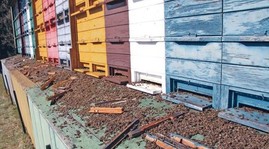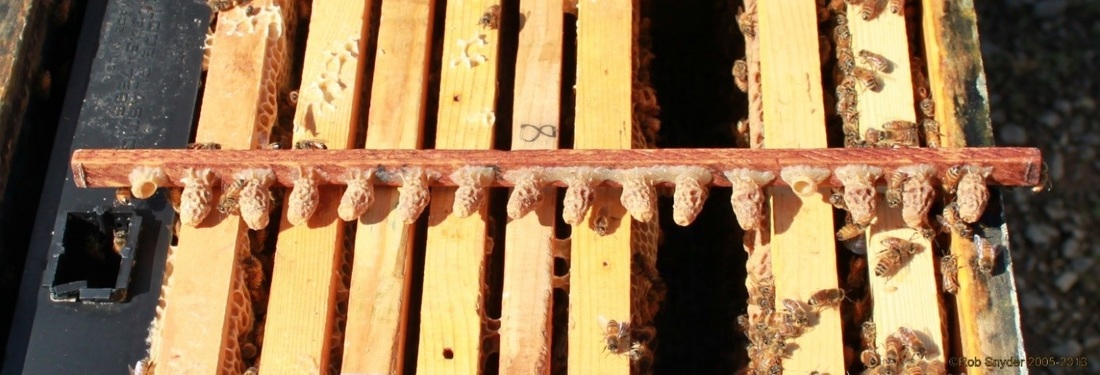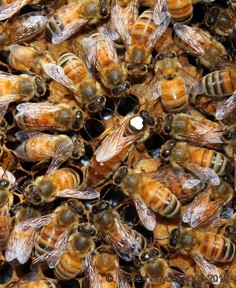What impact do pesticides have on Honey bees? Honey bee health is impacted by a variety of factors (such as pests, disease, and nutritional stress) and a multitude of interactions between these factors, making the solution to our nation’s bee health problem a difficult one to find. However, when the topic of honey bee health comes up in the media, the focus is almost always on pesticides. While pesticides are most certainly an issue for honey bees, it is important to realize that real-world exposure levels must be considered when looking at how pesticides can affect bee health. Dr. Reed Johnson of Ohio State University has done just this. As the colloquium guest of the UMD Entomology graduate students, Dr. Johnson discussed results of studies performed by his team on real-world agricultural field pesticide exposures for honey bee colonies.  A pesticide kill that resulted in piles of dead bees out front of their colonies. Photo credit: http://www.centerforfoodsafety.org/issues/304/pollinators-and-pesticides/press-releases/2053/uk-parliamentary-commission-calls-for-moratorium-on-bee-killing-pesticides# A pesticide kill that resulted in piles of dead bees out front of their colonies. Photo credit: http://www.centerforfoodsafety.org/issues/304/pollinators-and-pesticides/press-releases/2053/uk-parliamentary-commission-calls-for-moratorium-on-bee-killing-pesticides# Pesticides need an EPA Risk Assessment in order to be registered and authorized for use. The risk to bees is judged through a calculated Risk Quotient. The criteria of acceptable risks have also become stricter: it is not enough anymore for a pesticide to just not kill bees, to register a product, applicants need to prove that they do not harm any pollination services, biodiversity and hive products. The new regulations made overt and massive bee kills rarer, but they still present some limitations. For one, the Risk Quotients are based on testing done on individual adult bees. But honey bees do not live as individual bees; they are part of a superorganism: the colony. Testing the impact of pesticides on whole colonies is a challenging task. One colony can contain up to 50,000 individuals in a variety of reproductive castes and life stages. With this in mind, Dr. Johnson chose to conduct an in-hive based study in an attempt to solve a problem faced by a select group of California beekeepers (Johnson & Percel 2013). Almonds are a major pollinator crop in the US. With over 800,000 acres of almonds in the Central Valley of California, and about 2 honey bee colonies required per acre, almonds pollination contracts are a major source of revenue for US beekeepers. Additionally, some beekeepers in this region of California also specialize in queen rearing. Each year over 1 million queens are produced in the region. A few years back, those queen producers started complaining that about 80% of their queens were dying after the almond bloom. Was a product used during the bloom responsible? Several pesticides, labelled “bee safe” were indeed applied while flowers were in bloom: fungicides, herbicides and a few insecticides, none of them acutely toxic to bees according to standard testing. One of them in particular, received a lot of blame from beekeepers: the fungicide Pristine. In 2012, Dr. Johnson performed a full hive study to test the effect of Pristine on queen development using field realistic levels of exposure (Johnson & Percel 2013). The colonies were given frames of pollen contaminated with different concentration of Pristine. For comparison, the experiment also provided a negative control (non-contaminated pollen, which should yield no effect on development) and a positive control (contaminated-pollen with a chemical known to impact developing bees: the Insect Growth Regulator Diflubenzeron). The positive control is an essential part of a good scientific study: if no effect can be seen in the positive control, the conclusion should be that the something in the method of application was deficient rather than that the product had no effect. Each colony in the study was used to rear queens and the survival of those queens was followed throughout their development, from egg until emergence. The results showed that the method was appropriate: the positive control was associated with a high level of kill in the queens, as expected. But the different concentration of Pristine did not seem to have an effect on queen survival: the levels were similar to the negative control. So, if Pristine was not killing the queens in CA almonds, what was? The solution to this question was found in the CA Pesticide Database. California is the only US state in which every pesticide application has to be recorded in an official database. This mine of information provides a comprehensive documentation of all pesticide applications since the 1990’s. The database revealed that a certain insecticide was regularly sprayed during bloom on almonds, to control for the Peach Twig Borer. The name of this insecticide: Diflubenzuron. Does that ring a bell? This was the Insect Growth Regulator that was used as a positive control in Johnson’s study. Dr. Johnson performed another study, with the same design, to test different concentration of Diflubenzuron and found a clear dose-response relation: at high concentrations, the product would kill all queens; at moderate concentrations, the product had a marked effect. Interestingly, that product used to be labelled “bee safe”, because when tested on workers, the product did not seem to have such an effect. Pesticide Risk Assessments should represent complete assessments of risk and the examples provided by Dr. Johnson pointed to the limitations of the current standard methods required by regulations. By focusing on individual worker adults, and ignoring the impact on the other castes (such as the queens), other life stages, and whole colony impacts, current risk quotients are under-evaluating the real risk of pesticides to beneficial insects, such as honey bees. Another limitation of standard methods is how they focus on single pesticide exposure. We know that bees are never exposed to only one product at a time: 96% of pesticide applications are performed as “tank mixes” where several products are mixed together. Despite the confusion surrounding Colony Collapse Disorder, honey bee population trends, and mortalities, one thing can be certain: beekeepers in the US are losing an unacceptable number of colonies every year. So far, beekeepers have been able to keep up with their losses by splitting colonies, but at great cost, both in labor and financially. Beekeeping is harder today than it was in the past. As a result, managed bees have become more valuable, and the level of loss that a beekeeper would deem acceptable reduced. While not the only problem for honey bees, pesticide exposure is certainly a noteworthy one. Click here to see more of Dr. Johnson’s work on the effects of pesticides on honey bees (Johnson et al., 2010). References:
Johnson, R. M., Ellis, M. D., Mullin, C. A., & Frazier, M. (2010). Pesticides and honey bee toxicity - USA. Apidologie, 41(3), 312-331. doi:10.1051/apido/2010018 Johnson, R. M., & Percel, E. G. (2013). Effect of a Fungicide and Spray Adjuvant on Queen-Rearing Success in Honey Bees (Hymenoptera: Apidae). Journal of Economic Entomology, 106(5), 1952-1957. doi:10.1603/ec13199 About the Authors: Nathalie Steinhauer is a PhD student working in Dennis vanEngelsdorp’s Lab. She links the risk factors associated with beekeeping management to colony mortality. Andrew Garavito is a Master’s student in Dennis vanEngelsdorp’s Lab. He is studying honey bees; with a focus on the diversity of pollen types brought in by foragers, and the health effects of different pollen diets. Meghan McConnell is a Master’s student in Dennis vanEngelsdorp’s Lab. She is studying mechanical methods of control for the honey bee parasite Varroa destructor. Comments are closed.
|
Categories
All
Archives
June 2024
|
Department of Entomology
University of Maryland
4112 Plant Sciences Building
College Park, MD 20742-4454
USA
Telephone: 301.405.3911
Fax: 301.314.9290
University of Maryland
4112 Plant Sciences Building
College Park, MD 20742-4454
USA
Telephone: 301.405.3911
Fax: 301.314.9290



 RSS Feed
RSS Feed




